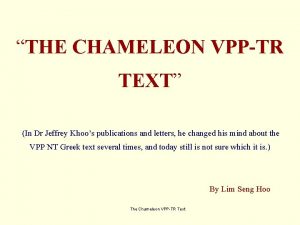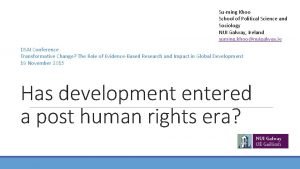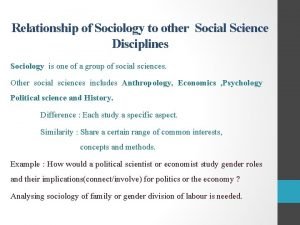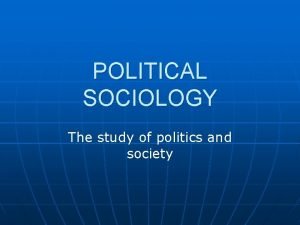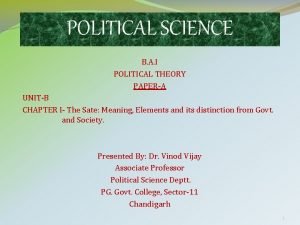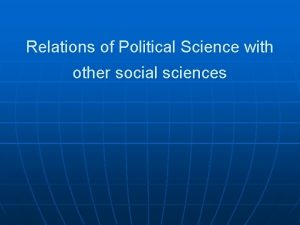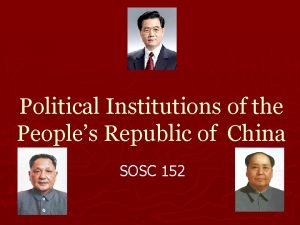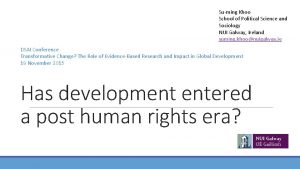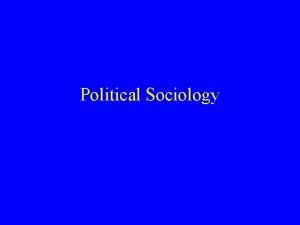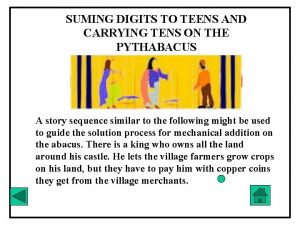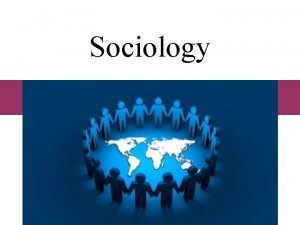Suming Khoo School of Political Science and Sociology







- Slides: 7

Su-ming Khoo School of Political Science and Sociology NUI Galway, Ireland suming. khoo@nuigalway. ie DSAI Conference Transformative Change? The Role of Evidence-Based Research and Impact in Global Development 19 November 2015 Has development entered a post human rights era?

Paper overview 1. Kairos – solidarity and development as vector of rights 2. ‘Human Rights’ enters development: after apartheid, after genocide 3. Social science and human rights: data and measurement to close the escape hatch 4. Global goals and divergence – Where did human rights go in the SDGs? 5. The transformative demand – human rights as victims justice or survivor’s justice

Kairos 1990 s – transformative opportunities for ‘development’ Transformation from economism to humanism (Gasper 2004) - human development paradigm Democratic transitions – new opportunities for participation Increased development interest in participation, agency UN Declaration on a Right to Development (UN 1986): ◦ ‘Third generation’ solidarity right unites first and second generation rights (Wellman 2000) ◦ development focused on people’s right to participate and benefit (DRD 1986) ◦ Vector (Sengupta 2002) or ‘umbrella’ (Rosas 2001) of indivisible rights

Human Rights enters development South Africa’s transformative politics: from a racial contract of domination (Pateman & Mills 2007) to 1994 ◦ ‘Democratising development through a democratic politics of socio-economic rights (Jones & Stokke 2005, 2) Rwanda genocide 1994 ◦ ◦ a turning point for development, human rights and the international community’s role (Uvin 2001, 76) Gross, systematic HR violations precursor to genocide? Discomfort with positive evaluations of economic ‘development’ and large amounts of aid a ‘model of development…full to the brim with development projects and technical assistance…perhaps the highest density of technical assistance per square kilometre in the world’ (op cit, 95) ◦ Challenge ‘…a much deeper mainstreaming of human rights and conflict resolution’, trying harder to fundamentally connect ‘wealth of facts’ about Rwanda to better forms of social science theorizing

Social science enters human rights Social science brings human rights ‘back to reality…both objective processes and structures and of subjective meanings and values’ (Freeman, 2002, p. 99). Jabine & Claude (1992) Human Rights and Statistics New work on conceptualizing, measuring and evaluating human rights (Landman & Carvalho, 2010) Renewed interest in ESCR began to demand evaluations of ‘resource constraints’ viz progressive realization of ESCR ◦ Toolkit to ‘close the escape hatch’ ◦ ‘hold governments accountable for policies and practices that turn millions of people into victims of avoidable deprivations such as illiteracy, malnutrition, preventable diseases, and homelessness’ (Felner 2009, 404) ◦ macroeconomic policies and human rights: public expenditure, taxation, trade policy and regulation (Elson & Balakrishnan, 2011).

Where did human rights go? ? Political stalemate and failure to reach consensus on key indicators and criteria for the Right to Development (Fukuda-Parr 2009, 165) Did HR remain relevant in MDGs? (ibid)? MDGs omitted explicit mention of human rights ◦ In favour of goals, targets HRBA – the convergence of human rights and development based on HR principles of i) equality/nondiscrimination, ii)true participation, iii) indivisibility and interdependence Human rights has lost traction in the SDG process (Brolan et al 2015) ◦ ◦ ◦ Everywhere but not somewhere Sidelining of right to health is part of general sidelining of human rights: ‘difficult issues’ Anticipated particular anxieties about SRHR Too big to be specifically defined as a goal Given that targets are where the action is, it would be too difficult to implement Already covered by some existing agenda and target eg UHC

The transformative demand Human rights has followed template of ‘victim’s justice’ set by Nuremberg (Mamdani, 2014) Weakness of HR is its antipolitical stance ◦ individual criminalization ‘put the focus on the perpetrators, ◦ at the expense of a focus on the issues that drive the violence’ (compare Uvin: structural violence) Compare S. Africa’s ‘surrogate Nuremberg’ TRC with CODESA process ◦ Transformation to a state that can govern not merely in the name of past victims, but addressing the fact that all are ‘survivors’ who must live together. Alston (2005) what about the private sector vs state responsibility? Where there is a clash between private and ‘peoples’ interests in development issues, HRBAs tend to focus on access or procedural rights SD requires HRBA to address ◦ deeper democratization of development processes ◦ re-integration of human and environmental principles into HR and Dev ◦ Development of concrete arrangements for responsibility and benefit sharing
